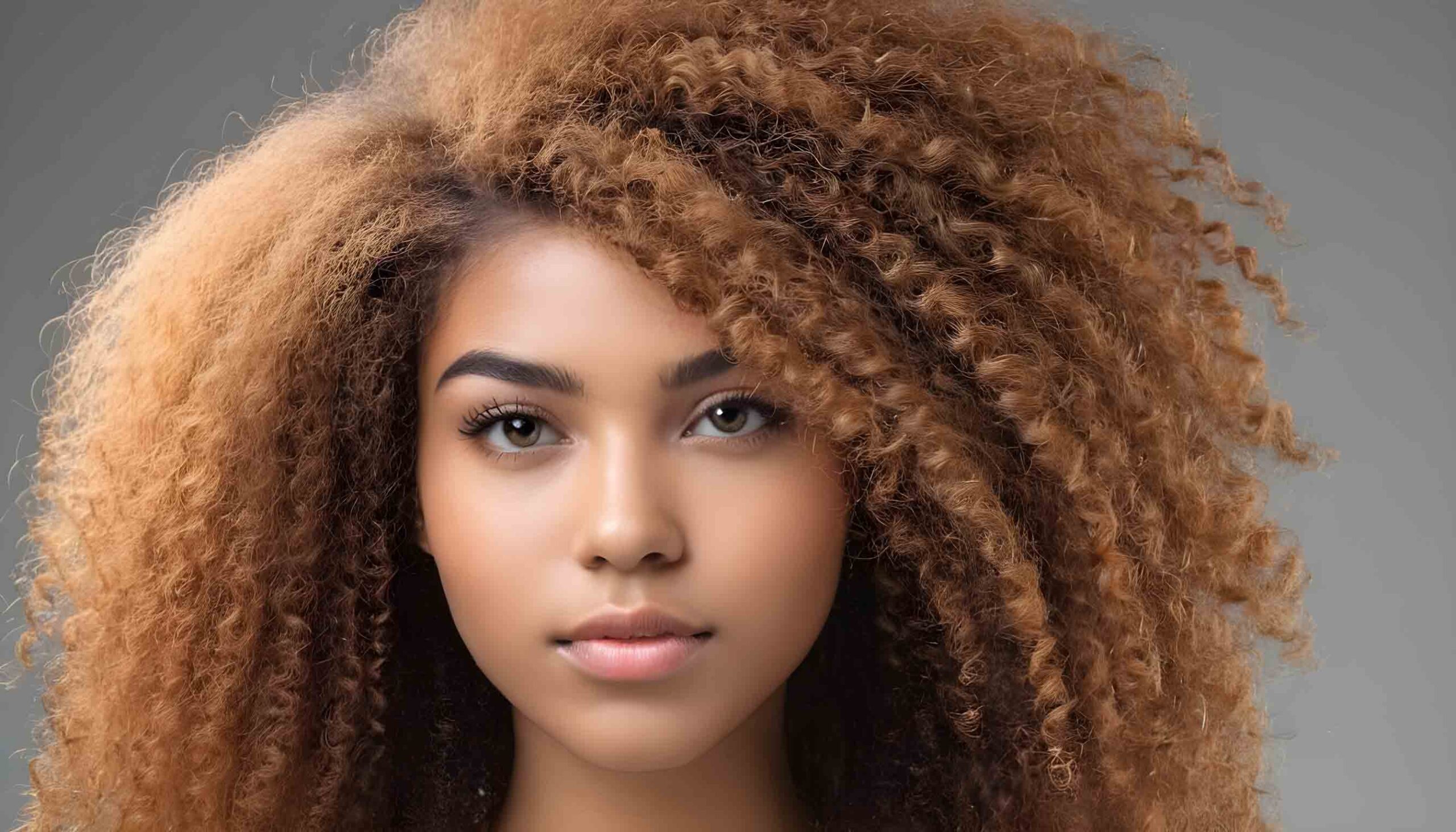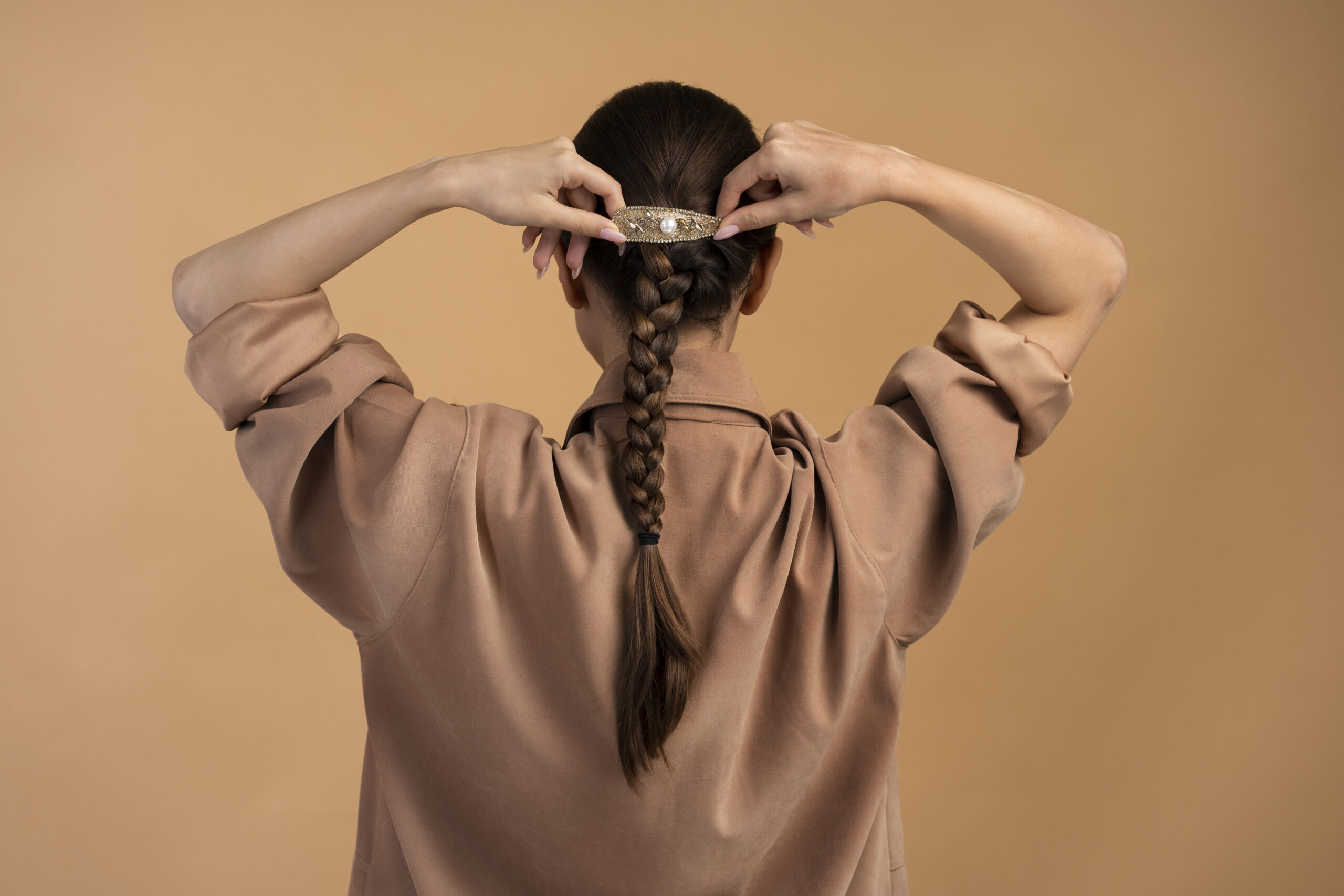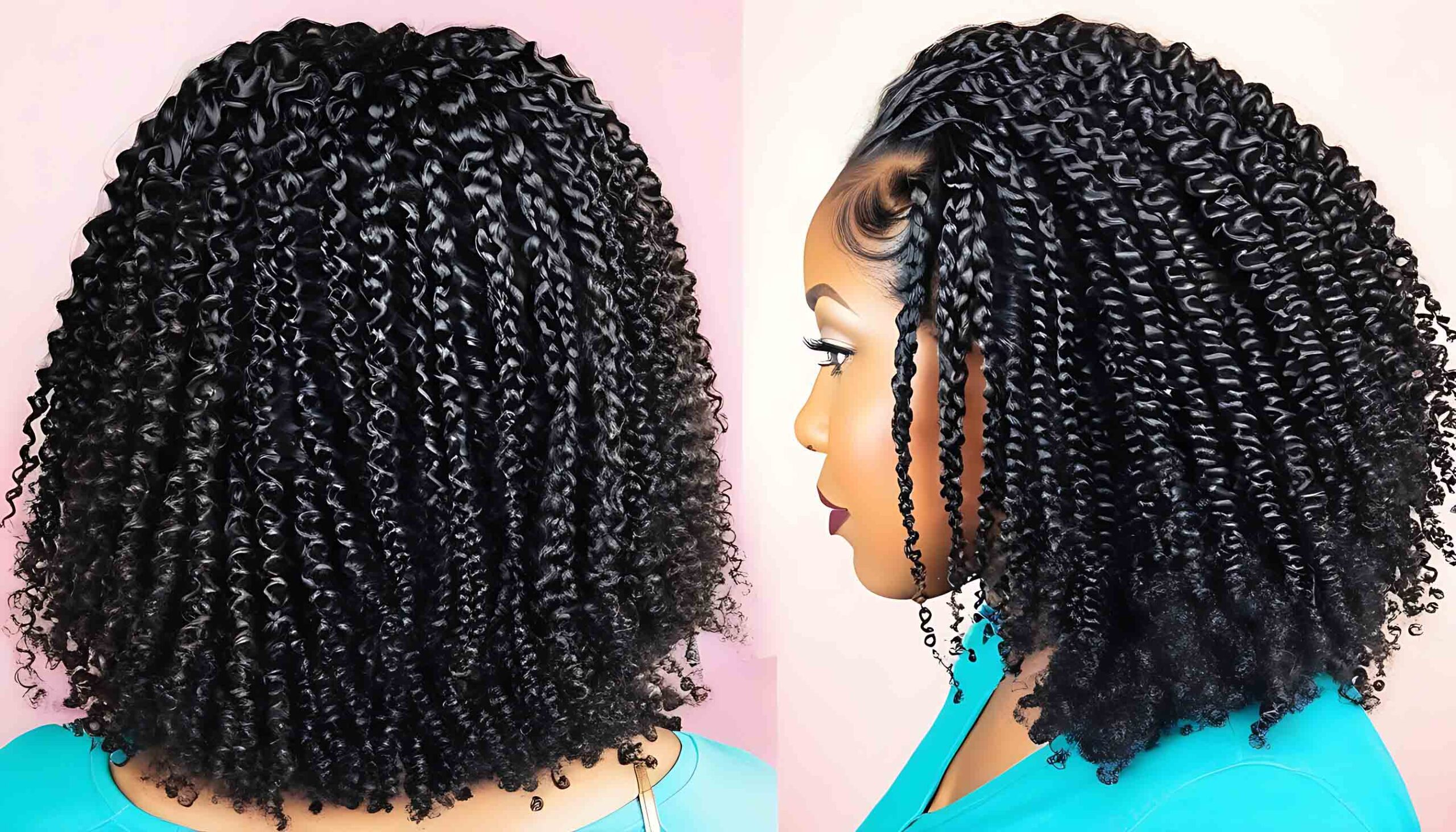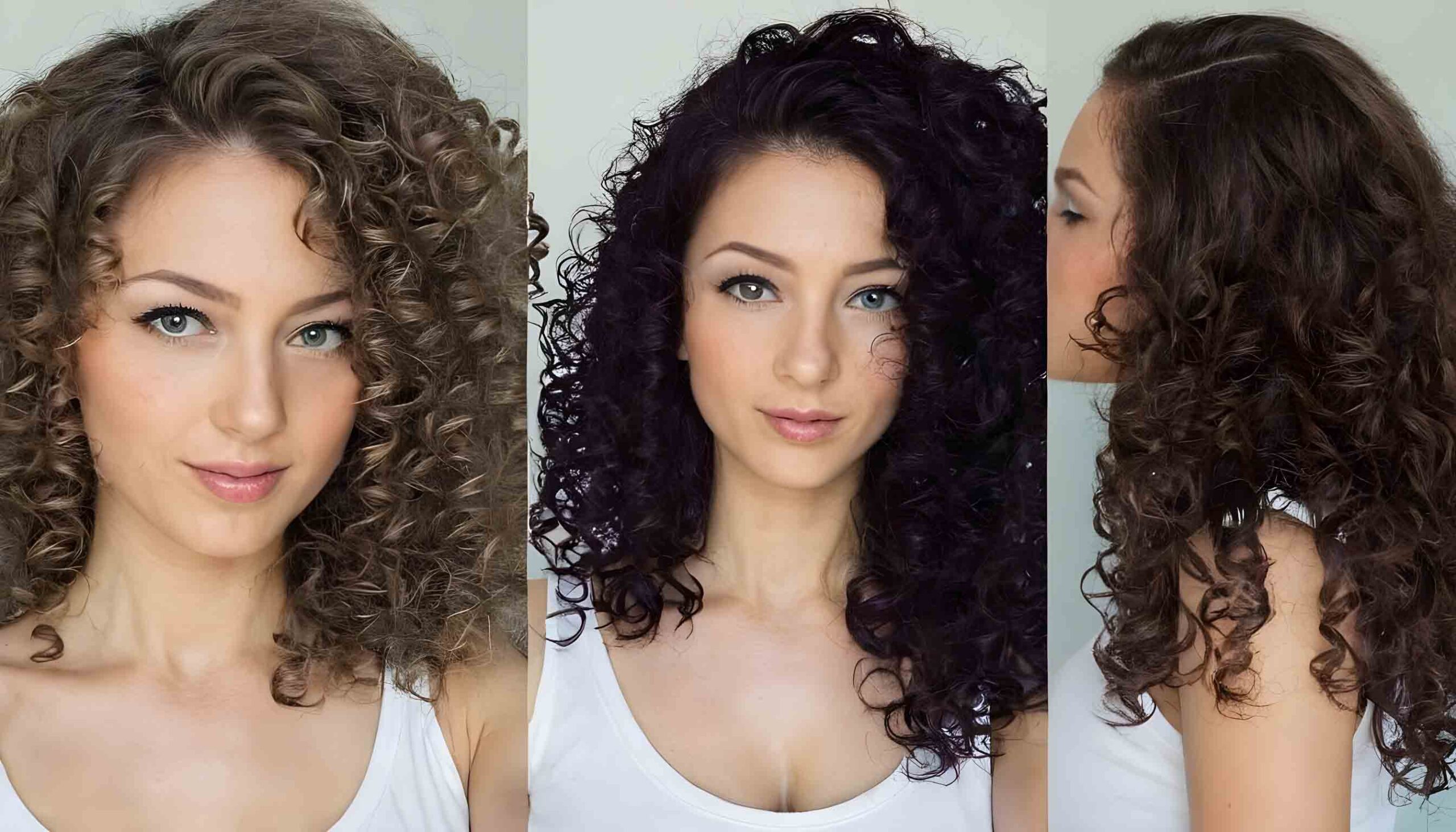Discover everything you need to know about caring for coily hair textures. From understanding your curl pattern to finding the right products and techniques, this guide covers it all.
Coily hair features very tight, springy coils that tend to have significant shrinkage when dry. The coils are naturally fragile and prone to dryness, making moisture retention key. Learn proper techniques like deep conditioning, gentle detangling, protective styling, and silk pillowcases.
We explain the different types of coily hair, from loose ringlets (4A) to tight zigzag coils (4C). See how your coil size and shape impact your care regimen. Plus, tips to enhance definition, fight frizz and prevent breakage for your curl type.
The right products make caring for coily hair much easier. We recommend what ingredients to look for and what to avoid when shopping. From pre-poo oils to curl-defining creams, these products boost moisture and soil health.
Coily hair deserves special care and handling. Follow our tips on everything from the ideal wash day routine to nighttime hair protection. Handle coils gently, keep hair hydrated, and boost the definition for thriving curls!
What Is Coily Hair?
Coily hair is a hair texture that features very tight curls and coils. The curls tend to be springy and can shrink significantly from their stretched length. Coily hair falls under the Type 4 category on the hair typing system and is generally graded from 4A to 4C.
4A hair has tight S-shaped curls that form springy ringlets. 4B hair has tighter coils that are more fragile and prone to damage. 4C hair has the tightest coils that tend to shrink up into tight zigzags close to the scalp.
Coily hair has a fragile structure and requires specialized care to maintain moisture, reduce breakage, and enhance definition. The tight curls create difficulty distributing natural oils from the scalp down the hair shaft, resulting in increased dryness. Coily hair benefits from gentle detangling, protective styling, and products that provide lasting hydration.
Everything You Need to Know about Coily Hair
Coily hair is one of the most misunderstood textures. While often categorized together with curly hair, oily hair has distinct properties that require a tailored approach. Here’s a breakdown of how coily hair is defined:
Natural oils
Sebum, the oil produced by the scalp, has difficulty coating and penetrating each coil. This leads to increased dryness and breakage. Products like hair butter and oils can supplement the lack of natural oils.
Moisture
The coils’ density limits moisture from properly saturating each strand. Regular deep conditioning provides lasting hydration.
Hair care products
Ingredients like sulfates and silicones can dry out and coat oily hair. Seek out products free of these ingredients.
Detangling
Finger detangling helps prevent breakage. Never brush coily hair when dry.
Protective styling
Low manipulation styles like braids help retain moisture and prevent damage from combing and heat.
Sleeping habits
Friction from cotton pillowcases can lead to breakage. Satin pillowcases or bonnets reduce friction.
With the right regimen, oily hair can thrive! Focus on moisture retention, protective styling, and minimal heat for healthy, defined curls.
Natural Curl: How to Care for Coily Curls
Coily curls require specialized care to look and feel their best. Here are tips for maintaining beautiful, hydrated coils:
Try oils
Pre-poo with oils like olive, coconut, or castor to lubricate and nourish strands.
Hair butter
Whipped butter like shea or cocoa butter melts into hair to seal in moisture.
Give your hair more moisture
Deep condition after every shampoo, and use leave-in conditioners and curl creams.
Eliminate hair care products with silicones
Silicones coat the hair shaft preventing moisture from absorbing.
Avoid any hair care products with mineral oils
Mineral oil can build up and prevent moisture absorption.
Deep conditioning, deep conditioning, deep conditioning
The dense coils need heavy moisturizing. Do weekly treatments.
Never comb hair dry
Always detangle gently with tons of conditioner in the shower.
Protective styling methods
Low manipulation styles like braids or buns protect your coils between washes.
Oil is not the same as moisture
Seal in moisture with creamy, water-based products before using oils.
Step up your sleeping habits
Wrapping hair in a satin scarf or bonnet prevents friction and breakage overnight.
Clip-ins and wigs
Gives coily hair a break from manipulation. Use human hair versions for versatility.
With the right care, coily curls will thrive and flourish!
THE ULTIMATE GUIDE TO COILY HAIR
Coily hair can be difficult to manage, but this guide will walk you through everything you need to know to care for your coils. Let’s dive in!
Characteristics Of Coily Hair
- Extremely tight, springy curls
- Significant shrinkage when dry
- Prone to dryness and breakage
- Sebum has trouble traveling down shafts
- Difficulty retaining moisture
4A Hair Type
- Tight “S” pattern coils
- Springy ringlets
- The more defined curl pattern
- Medium-sized coils
- Less shrinkage than 4B-4C
4B Hair Type
- Extremely tight, fragile coils
- Z-shaped pattern
- Coils are small and close together
- Prone to dryness and breakage
4C Hair Type
- Tightest coil pattern
- “Z” shaped coils that shrink into zigzags
- Very fragile and densely packed
- Most prone to dryness
- Recommended to avoid heat styling
How Should You Wash Coily Hair
- Shampoo 1x per week maximum
- Co-wash in between (conditioner wash)
- Deep condition after every wash
- Detangle with tons of conditioner
- Avoid brushing when dry
- Air dry or use a microfiber towel
Top Tips for Styling Coily Hair
- Define curls with a curl cream + gel/mousse combo
- Use a leave-in conditioner before styling
- Diffuse or air-dry
- Refresh curls with water + leave in
- Protect hair overnight (satin bonnet/pillowcase)
How to Protect Coily Hair in Between Washes
- Wear protective styles (braids, buns, etc.)
- Use a satin bonnet or pillowcase
- Avoid friction from rough fabrics
- Moisturize daily with water-based products
- Limit the use of heat styling tools
How to Refresh Coily Hair
- Mist hair with water/leave-in conditioner
- Scrunch in curl cream or styling product
- Diffuse or air-dry
- Pineapple hair (loosely ponytail on top of head)
- Wrap hair at night
With the right care, your coils will thrive!
What’s the Difference Between Coily Hair and Curly Hair?
Coily and curly hair are often lumped together, but they have distinct properties. Here are the key differences:
Curly hair type:
- Defined, spiraled pattern
- Loops and waves
- More flex and movement
- Looser curl pattern
- Higher moisture retention
- Less prone to shrinkage
- Requires less intensive moisture
Coily hair type:
- Extremely tight, springy coils
- Zig-zag pattern, less defined
- Very fragile and prone to breakage
- Significant shrinkage when dry
- Low moisture retention
- Needs heavy, regular moisturizing
While both curl types need care to maintain definition and moisture, oily hair requires more intensive moisture and gentler handling to prevent damage. The coil pattern also leads to more shrinkage for oily hair when dry. Regardless of curl type, never brush dry and focus on hydration and curl definition. Both hair types can have a beautiful, defined texture when properly cared for.
Hair Care Tips for Coily and Curly Hair
Here are tips that apply to caring for all types of coils and curls:
Moisturize Regularly
- Hydration is key for defined coils
- Use leave-in conditioner
- Seal in moisture with oils and butter
Shampoo less often
- 1-2 times per week maximum
- Co-wash in between to hydrate
Use a wide-tooth comb
- Start detangling at the bottom
- Work upwards gently
Protect your hair while you sleep
- Satin pillowcase prevents friction
- Pineapple or loose braid
- Bonnet or scarf wrap
Avoid Heat Styling
- Allow hair to air dry
- Diffuse if you must use heat
- Limit the use of hot tools
Trim Your Hair Regularly
- Schedule trims every 8-12 weeks
- Prevent split ends and breakage
Regardless of the exact curl pattern, moisture and gentle handling are key for defined, healthy coils!
Benefits of Using Controlled Chaos Hair Products
The Controlled Chaos line was specially formulated for oily and curly hair. Here are the benefits of using their products:
Controlled Chaos Hair Products for Coily and Curly Hair
Curl Cleanser
- Sulfate-free removes buildup
- Quinoa extract gently cleanses
- Amaranth oil nourishes hair
Curl Conditioner
- Intense hydration
- Shea butter deeply moisturizes
- Vitamin E repairs damage
Curl Crème
- Defines and separates coils
- Olive oil provides shine
- Creates frizz-free definition
How to Care for Coily Hair
Coily hair requires specialized care to look and feel its best. Here are tips for maintaining healthy, defined coils:
Why is Coily Hair Prone to Dryness?
Coily hair is prone to dryness for a few reasons:
- Sebum from the scalp has difficulty coating the coils
- The tight curl pattern limits moisture from penetrating the hair shaft
- Coily hair has fewer cuticle layers to retain moisture
- Environmental factors like sun, wind, and cold easily deplete moisture
To prevent dryness, it’s key to provide additional moisture through leave-in conditioners, creams, and oils. Deep conditioning treatments also help provide an added dose of hydration. Avoid products with drying ingredients like sulfates and silicones as well.
Swap Cotton for Silk
Cotton pillowcases can cause friction that leads to the breakage of oily hair. Swap your pillowcase for a silk or satin version instead. The smoother texture prevents strands from catching and pulling. You can also wrap your hair in a silk or satin scarf or bonnet before bed.
Daily Damage Control
Coily hair requires gentle, low manipulation to prevent damage. Here are tips:
- Detangle with tons of conditioner in the shower using fingers or a wide-tooth comb.
- Allow hair to air dry rather than using heat tools.
- Wear low-manipulation protective styles.
- Use satin scrunchies rather than regular hair ties.
- Avoid excessive brushing and tight hairstyles that pull on the delicate strands.
Common Coily Hair Problems and Solutions
Coily hair comes with its unique challenges. Here are solutions for some common issues:
Fighting Frizz
- Use styling products like gel or mousse to enhance the definition
- Lock in moisture with creamy leave-in conditioners
- Finish with an oil to seal hydration
- Diffuse hair instead of air-drying
Saying Goodbye to Dryness
- Deep condition 1-2 times per week
- Avoid sulfate shampoos that strip moisture
- Cleanse hair only 1-2 times per week
- Use a hydrating hair mask for added moisture
Protecting from Harsh Conditions
- Seal hair with oil before going outside
- Wear a satin-lined hat in cold weather
- Sleep with a silk bonnet or pillowcase
- Always apply styling products to soaking-wet hair
Styling Gently
- Detangle with lots of conditioner and fingers
- Allow hair to air dry rather than using heat tools
- Sleep with hair in a loose style like a pineapple
- Opt for loose braids, buns, and low-manipulation styles
With some trial and error, you’ll find the right products and techniques to help your coils reach their full potential!
Haircuts and Styles for Coily Hair
Certain cuts and styles work better with oily textures. Here are the top options to consider:
Cropped Coif
A short, tapered cut is great for showing off oily texture. The defined curls up top become the star of the show. Ask your stylist for layers to encourage bounce and movement.
Side Part Switch
A deep side part on stretched curls creates a pretty frame for the face. Add a side sweep of bangs to soften facial features. Define curls with mousse for a chic style.
Pin Backed and Pretty
For an easy updo, part hair down the middle and gather each side into a low bun or flat twist. Pin back the front pieces for a pretty, pulled-together look.
No matter how you wear your coily locks, embrace and enhance your beautiful, unique texture! With the right haircut and styling, your coils will be unstoppable.
Coily Hair Type
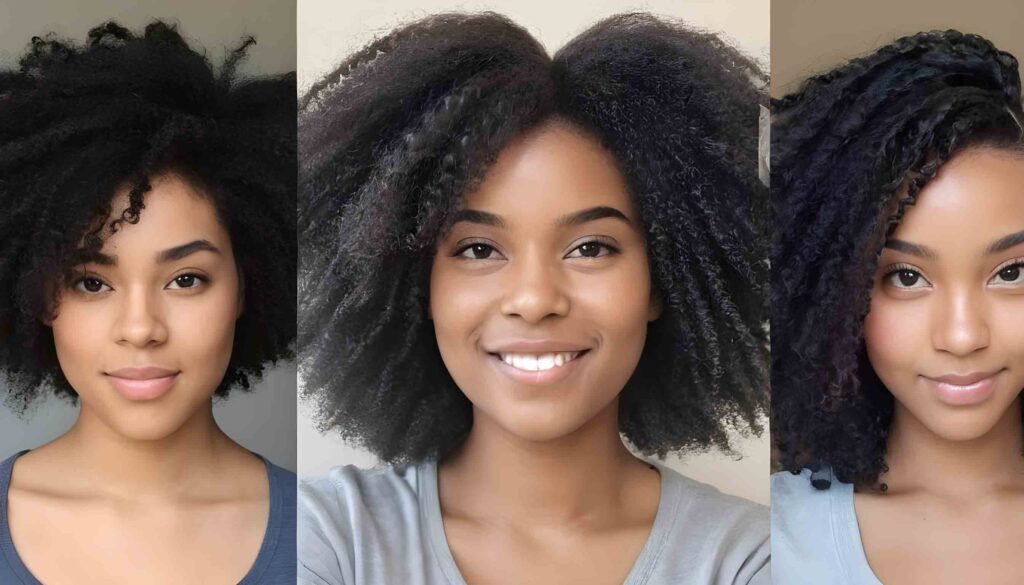
Coily hair is categorized into sub-types based on the coil pattern and curl size. Understanding your specific coily hair type is key to providing it with tailored care and styling.
Type 4A hair has springy, well-defined ringlets that can form tight spirals. The S-shaped coils are relatively large and uniform in size. 4A hair has more flexibility and elongation potential than the other Type 4 hair types when properly cared for.
Those with Type 4B coily hair have very tight, Z-shaped coils that are close together and lack definition. The fragile coils have a zig-zag appearance and tend to be quite small in circumference. 4B hair shrinks noticeably when dry and is prone to dryness and breakage without sufficient moisture.
Type 4C coily hair is characterized by the tightest coil pattern in the Type 4 category. The coils are similar to 4B hair, with a zig-zag shape, but shrink extremely tight to the scalp. 4C hair appears in small sections or clumps rather than defined ringlets. This hair type requires the most moisture and gentle handling to prevent excessive dryness and breakage.
No matter your specific Type 4 coily hair, embracing your curl pattern and providing it with the care it craves will help your coils thrive in all their glory. Focus on moisture retention, protective styling, and enhancing definition for your coily crown!
Curly vs Coily Hair
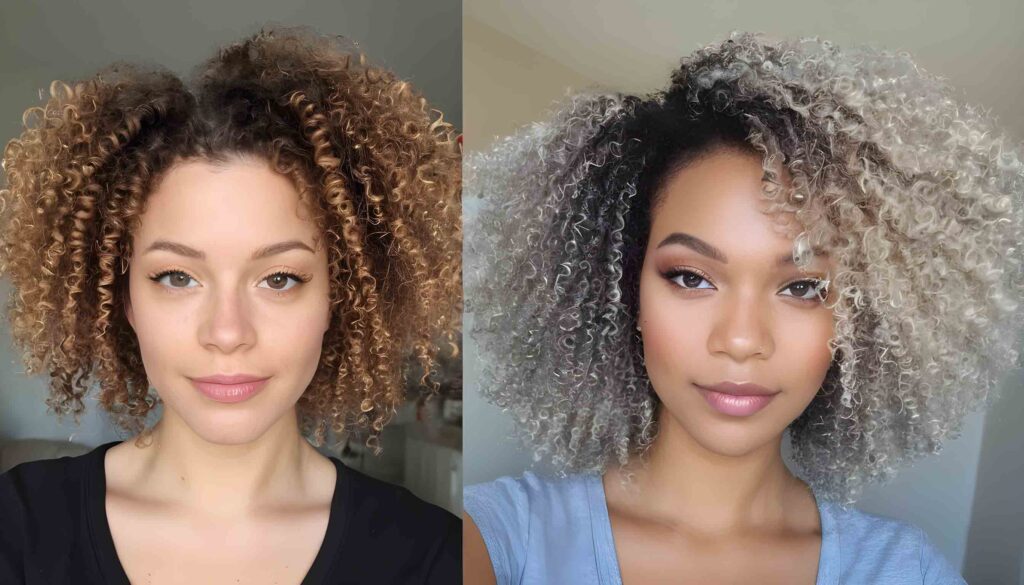
Curly and coily hair are often grouped, but they have distinct properties that impact care. Coily hair features tight, shrinkable coils while curly hair has defined waves and spirals that are looser in texture.
Curly hair tends to have more flexibility, movement, and elongation potential. The curl pattern features defined ringlets, loops, and waves. Curly hair is less prone to extreme shrinking and breakage. It requires regular moisture but is not as intensive as coily hair.
Coily hair has springy, zig-zag-shaped coils that are prone to shrinking significantly when dry. The coils are extremely fragile and delicate, leading to increased dryness and breakage. Coily hair struggles to retain moisture in the tight coils. Sebum also has difficulty coating the coils from root to tip.
Coily hair needs deep conditioning treatments and extremely hydrating products to maintain moisture levels. Gentle handling is crucial to prevent damage and tangles. Things like silk pillowcases, protective styles, and minimal heat styling become necessities.
While both curl types deserve care and definition, coily hair requires more moisture and gentle handling to prevent breakage. Curly hair can withstand more manipulation and heat styling if desired. Regardless of curl type, never brush dry, focus on hydration, and enhance coils with the proper styling products. Celebrate both textures for their unique beauty and care needs.
Kinky Coily Hair
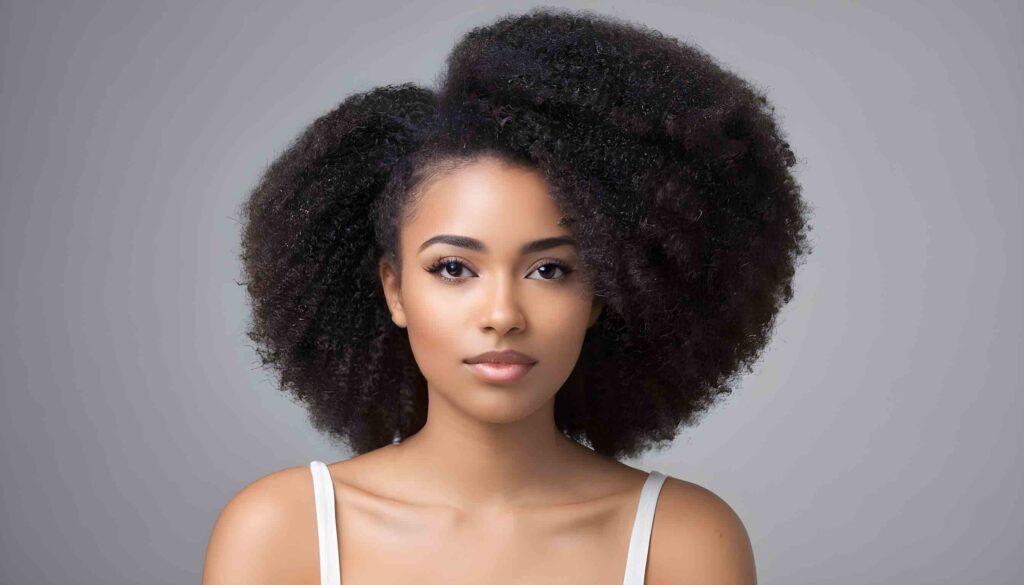
Kinky coily hair is a blend of extremely tight, coiled textures. It shares characteristics of both kinky and coily hair types. This unique blend requires special care to thrive.
Like coily hair, kinky coily hair contains springy, well-defined coils. The coils are very tight, shrinking up close to the scalp when dry. Intensive moisture is needed to hydrate each coil. Sebum also struggles to travel down the coils.
The kinky element shows up in the more fragile, dry texture. Kinky coily hair is delicate and prone to snapping and tangling during handling. Extra gentle detangling is required. The coils tend to have a less defined pattern and more matting.
Kinky coily hair shares the shrinkage of coily hair while having the dry, cottony texture of kinky hair. The result is hair that requires very gentle care plus deep hydration. Things like protective styles, tons of conditioner during washes, and moisturizing daily are musts.
Products with moisturizing ingredients like shea butter, coconut oil, and aloe vera are ideal for kinky coily hair. Avoid potential irritants and drying ingredients like sulfates. Diffuse or air-dry hair to prevent extra handling. Sleep on silk pillowcases.
Kinky coily hair is a truly unique texture that needs customized care. Embrace the beautiful blend of tight coils while handling them with extra gentleness. With TLC, kinky coily hair will thrive!
Coily Hair Products
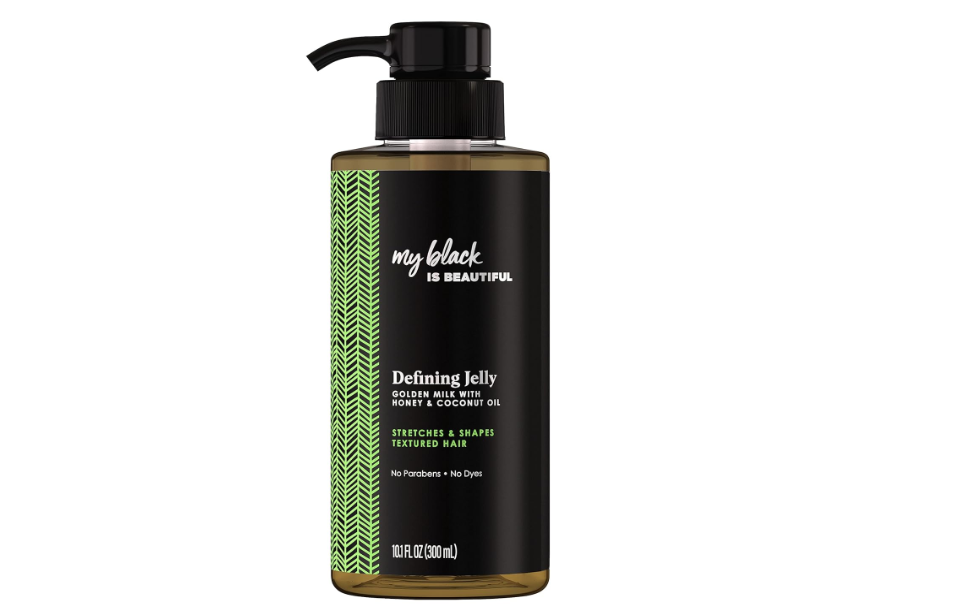
When shopping for products, it’s important to choose options specifically formulated for coily hair. Here’s what to look for:
Moisture is key for coily hair. Seek out shampoos, conditioners, and stylers that hydrate and contain ingredients like shea butter, coconut oil, aloe vera, and glycerin. Avoid sulfates in shampoos as they can strip moisture. Silicones in conditioners can cause buildup so opt for lighter options.
Cleansing coily hair too often can lead to dryness. Choose a gentle, moisturizing shampoo for once-weekly use. Co-wash (cleansing with conditioner only) for another mid-week wash. Deep conditioners provide an extra dose of moisture.
For styling, creamy leave-in conditioners help hydrate and detangle coils. Curl creams enhance definition. Gel or mousse helps lock in moisture and prevent frizz. Oils and butter seal everything in.
Look for the “curly girl approved” label on products to ensure they are free of drying ingredients like sulfates, silicones, alcohols, and parabens. Prioritize natural ingredients and formulas free of harsh chemicals.
When in doubt, ask a stylist who specializes in coily hair for recommendations. They can assess your hair and suggest products to suit your specific needs. Sample sizes allow you to test products without a big investment.
With the right coily hair products, your curls will thrive! Focus on hydration, definition, and frizz-fighting. Don’t be afraid to play with products until you find your favorites.
Conclusion
Coily hair is truly unique and requires specialized care. By following tips for moisture retention, protective styling, and gentle handling, coily curls can thrive and look defined. Deep conditioning, using curl creams, and silk pillowcases all help to enhance coils and prevent dryness and damage. Some chic styles and cuts can accentuate oily texture. Embrace your hair’s natural curl pattern and you’ll be amazed by its beauty and versatility. With the proper regimen, your coils will flourish.
Frequently Asked Questions
What are the 4A, 4B, and 4C hair types?
The 4 hair types refer to different coil patterns for oily hair:
- 4A: Tight “S” pattern coils that form springy ringlets
- 4B: Extremely tight, fragile Z-shaped coils, prone to breakage
- 4C: Tightest coil pattern, coils shrink into zigzags
Is 4A hair curly or coyly?
4A hair is classified as oily hair. Its tight coil pattern and high shrinkage differentiate it from looser curly hair types. While curly hair can have some coil patterns, 4A coils are smaller, tighter, and springier.
Does coily hair grow?
Yes, coily hair grows at the same average rate as other hair types, about 1/2 inch per month. The tight coils cause it to shrink as it grows, so the length may be less noticeable. With proper care, coily hair can grow long.
Is 3B hair coily?
No, 3B hair is not considered coily. It falls into the curly hair category, with its defined S-shaped waves and curls. Coily hair has a tighter coil pattern that commonly falls into the 4A-4C range.
What is coily hair?
Coily hair features very tight, springy coils that tend to shrink significantly from their stretched length. The coils are fragile and prone to dryness and breakage. Coily hair types are categorized from 4A to 4C.
What is the difference between curly and coily hair?
Curly hair has defined waves and spirals with more flex and movement. Coily hair has extremely tight, zig-zag-shaped coils that are fragile and prone to shrinkage. Curly hair typically has higher moisture retention while coily hair requires intensive moisture.
How do I know if I have kinky or coily hair?
Kinky and coily hair both have a tight coil pattern. Coily hair tends to have a defined springy coil shape, while kinky hair coils are less uniform and have more of a zig-zag pattern. Kinky hair also has more fragility.
Is coily hair dry?
Coily hair tends to be drier than other curl patterns. The tight coils make it difficult for moisture and oils to penetrate the hair shaft. Proper moisture techniques are required to keep coily hair hydrated.
Is 4C hair curly or coily?
4C hair is classified as coily due to its tight zig-zag pattern. The coils tend to clump together and lack definition. While curly hair can have some coils, 4C patterns are extremely tight.
How do I know if my hair is coily?
Signs your hair is coily include:
- Tight, springy coils
- Zig-zag curl pattern
- Significant shrinkage when dry
- Easily dries out
- Difficulty retaining moisture
- Breakage when brushed dry
How to take care of coily hair?
- Shampoo less frequently
- Deep condition 1-2 times per week
- Detangle with tons of conditioner
- Avoid heat styling when possible
- Air dry or diffuse
- Use rich, creamy moisturizers
- Protect hair overnight
What is the difference between coily and kinky hair?
Coily hair tends to have a defined springy curl pattern while kinky hair has less uniformity in the coils. Kinky hair features tighter zig-zags that are less organized. Coily hair has more spring and bounce while kinky hair tends to be drier and more fragile.
Is coily hair a type of curl?
Yes, coily hair is a type of curl pattern categorized under type 4 hair. Its defining characteristic is the very tight, springy coils that tend to shrink up. While coils are technically a form of curl, coily hair has distinct properties from loose curls.
Is 3C hair curly or coily?
3C hair is classified as curly, not coily. The 3 hair types have defined waves and spirals, whereas coily hair has tighter coils and more shrinkage. 3C hair has springy ringlets but is looser than the coils of type 4 hair.
Is my hair curly or coily?
If your hair has very tight, shrinking coils, it is likely coily. Coily hair is less defined, has more fragility, and requires intensive moisture. Curly hair has a looser curl pattern with spirals and waves that have more swing and movement. Examine your hair’s texture when wet to determine curl versus coil shape.
What is the difference between curly and curly coily?
Curly coily is a mix of curl patterns, with looser waves and defined ringlets combined with tighter springy coils. The variety in textures means this hair type needs care for both curls and coils. Focus on moisture, minimizing tangles, and enhancing both curl types.
Can coily hair be curly?
Yes, coily hair can have some curly elements while still being classified as type 4. Many people with coily hair have a mix of defined ringlets and tight coils, known as curly coily hair. The coils dominate in this mix, requiring intensive moisture.
Is 4c hair kinky or coily?
4c hair is considered coily rather than kinky. While it has texture shrinkage and fragility, 4c coils maintain a tight zig-zag shape vs. the less defined coils of kinky hair. The very tight coils are the signature of 4c coily hair.
What is kinky and coily hair?
Kinky and coily hair both have tightly coiled textures. Coily hair tends to have a defined springy curl pattern. Kinky hair has less uniformity in the coils, with tighter zig-zags that lack definition. Kinky hair is also extremely fragile and prone to dryness.
What is the difference between curly hair and kinky hair?
Curly hair has defined, spiral-shaped curls that are looser and have more swing. Kinky hair has very tight, fragile zig-zag coils that lack uniformity. Curly hair is easier to manage and style while kinky hair is extremely dry and delicate.
What is the kinkiest hair texture?
4C hair is considered the kinkiest hair texture. The tight, undefined coils shrink up into zig-zags close to the scalp. 4C hair is the most difficult to retain moisture and the most fragile curl type. Proper care is required to prevent breakage.
How do you treat coily hair?
- Shampoo minimally, 1x a week max
- The deep condition frequently, at least weekly
- Load conditioner to detangle, never comb dry
- Air dry or gently diffuse
- Use rich, creamy moisturizers
- Sleep with a silk pillowcase or bonnet
- Protective style using buns, braids, etc.
How do you control coily hair?
- Define coils with gel and curl cream
- Use moisturizing products when wet
- Allow hair to air dry fully
- Diffuse to enhance definition
- Pineapple or wrap hair at night
- Refresh with water/conditioner spray
- Limit heat styling
Which hair type is coily?
Coily hair is categorized under type 4 hair. The sub-types include:
- 4A: Tightly coiled S-shaped ringlets
- 4B: Extremely fragile, tight zig-zag coils
- 4C: Tightest zig-zag coils, prone to shrinkage
Hair must have the characteristic springy, shrinking coils to be considered truly coily.
How do you grow coily hair?
- Shampoo gently 1-2x per week
- The deep condition frequently with moisture masks
- Avoid excessive heat styling
- Wear hair in protective styles
- Use silk pillowcases to prevent breakage
- Handle hair gently when detangling
- Trim regularly to prevent split ends
- Keep hair moisturized daily

